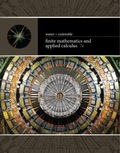
Some of the following exercises are similar or identical to exercises and examples in Chapter 4. Use matrix inverses to find the solutions. We suggest that you invert some of the matrices by hand and others using technology.
Resource Allocation You manage an ice cream factory that makes three flavors: Creamy Vanilla, Continental Mocha, and Succulent Strawberry. Into each batch of Creamy Vanilla go two eggs, one cup of milk, and two cups of cream. Into each batch of Continental Mocha go one egg, one cup of milk, and two cups of cream. Into each batch of Succulent Strawberry go one egg, two cups of milk, and one cup of cream. Your stocks of eggs, milk, and cream vary from day to day. How many batches of each flavor should you make in order to use up all of your ingredients if you have the following amounts in stock?
a. 350 eggs, 350 cups of milk, and 400 cups of cream
b. 400 eggs, 500 cups of milk, and 400 cups of cream
c. A eggs, B cups of milk, and C cups of cream
Want to see the full answer?
Check out a sample textbook solution
Chapter 5 Solutions
EBK FINITE MATH AND APPLIED CALCULUS
- 2. Find a matrix A with the following qualities a. A is 3 x 3. b. The matrix A is not lower triangular and is not upper triangular. c. At least one value in each row is not a 1, 2,-1, -2, or 0 d. A is invertible.arrow_forwardFind the exact area inside r=2sin(2\theta ) and outside r=\sqrt(3)arrow_forwardA 20 foot ladder rests on level ground; its head (top) is against a vertical wall. The bottom of the ladder begins by being 12 feet from the wall but begins moving away at the rate of 0.1 feet per second. At what rate is the top of the ladder slipping down the wall? You may use a calculator.arrow_forward
- Explain the key points and reasons for the establishment of 12.3.2(integral Test)arrow_forwardUse 12.4.2 to determine whether the infinite series on the right side of equation 12.6.5, 12.6.6 and 12.6.7 converges for every real number x.arrow_forwarduse Cauchy Mean-Value Theorem to derive Corollary 12.6.2, and then derive 12.6.3arrow_forward
 College AlgebraAlgebraISBN:9781305115545Author:James Stewart, Lothar Redlin, Saleem WatsonPublisher:Cengage Learning
College AlgebraAlgebraISBN:9781305115545Author:James Stewart, Lothar Redlin, Saleem WatsonPublisher:Cengage Learning
 College Algebra (MindTap Course List)AlgebraISBN:9781305652231Author:R. David Gustafson, Jeff HughesPublisher:Cengage Learning
College Algebra (MindTap Course List)AlgebraISBN:9781305652231Author:R. David Gustafson, Jeff HughesPublisher:Cengage Learning Algebra for College StudentsAlgebraISBN:9781285195780Author:Jerome E. Kaufmann, Karen L. SchwittersPublisher:Cengage Learning
Algebra for College StudentsAlgebraISBN:9781285195780Author:Jerome E. Kaufmann, Karen L. SchwittersPublisher:Cengage Learning






